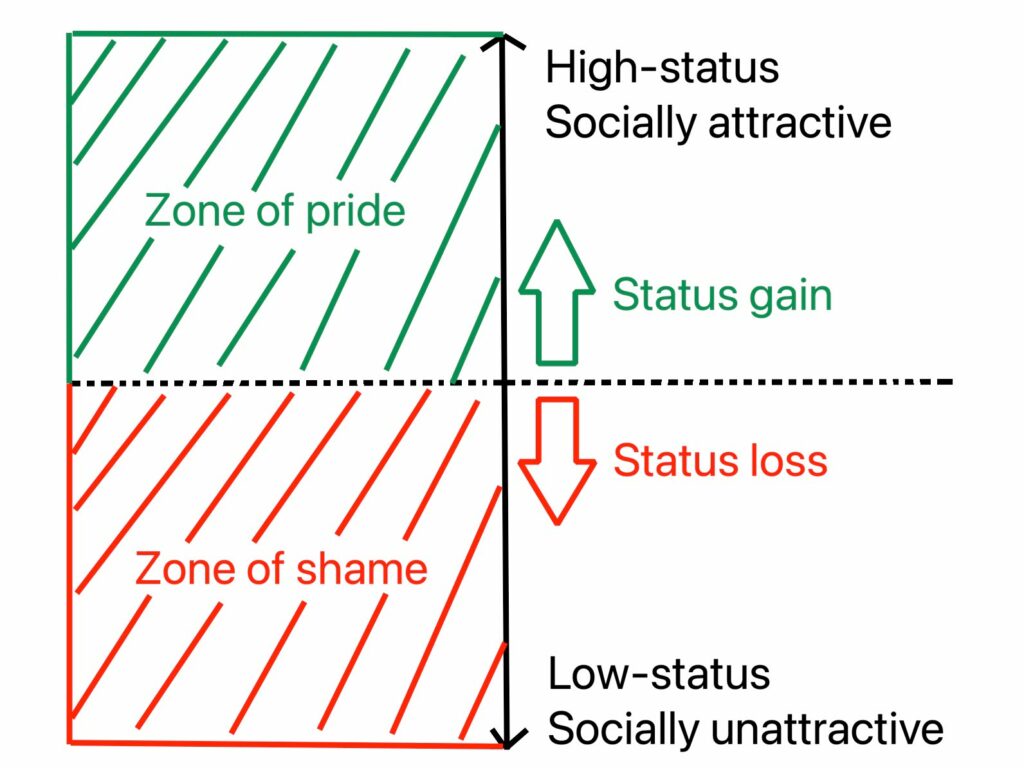Humans are social species. For any social species, social cohesion matters. Social cohesion is achieved when individuals can live together in reciprocal, ‘I scratch your back, and you scratch mine’ relationships.
An individual enters a reciprocal relationship with someone who adds value to their life. Valuable or high-value people, therefore, can better form relationships and foster social cohesion.

The more valuable a person is to a group, the higher their status. High-value and high-status people are socially attractive.1
In contrast, low-value and low-status people are socially unattractive and likely to be excluded from a group. Because they hardly contribute anything to the group. They tend to be takers, not givers.
Status gains (moving up in status) induce pride in a person, and status losses (moving down in status) cause shame.2

Pride acts as positive reinforcement. It’s your mind telling you:
“Great! Keep doing what you’ve been doing.”
Pride motivates you to become more prideful, i.e., move higher in status.
Shame is your mind’s way of punishing or inhibiting what you’ve been doing:
“Stop! Quit doing what you’ve been doing. Your status is low. We need to fix it.”
Transient vs. Toxic shame
Shame, though painful, is thus a normal human emotion that tells us we’ve lowered ourselves in the eyes of others. It’s a low-status indicator. Shame motivates us to stop engaging in behaviors perceived as ‘shameful’ by our social group.
Normal or transient shame is when you do something embarrassing, feel shameful, and then fix your behavior to regain status and social acceptance.
Toxic or internalized shame is a chronic sense of unworthiness and low self-esteem.
While ordinary people experience shame now and then and get over it, people with internalized shame suffer from various mental health problems.
Toxic shame originates in childhood and teenage years when a person over-relies on others for identity formation. The mistreatment from parents, teachers, and peers shapes a person’s self-image.
A shame wound develops in the person, which makes them believe they’re flawed:
“Something is wrong with me.”
Signs of shame
I’ve broadly classified the different signs of shame into three categories:
- Non-verbal signs
- Personality types
- Emotional states
The first category applies to both transient and toxic shame. The second and third category applies more to toxic shame.
A) Non-verbal signs of shame
In the animal kingdom, when a dominant animal seeks to attack a subordinate, the latter sends out certain submissive signals. These signals communicate to the dominant animal:
“I am harmless. Don’t fight me.”
The dominant animal establishes its dominance, and the submissive animal saves its life.
In humans, shame triggers a person to send out the same submissive signals. Since dominance correlates with high status and submissiveness with low status.3
A person experiencing shame feels unworthy and small. They adopt ‘hiding behaviors’ as a means of self-exclusion from the group that perceives them as inferior. These hiding behaviors include:
1. Avoiding eye contact
When people feel shame, they don’t think they’re worthy of connecting with others and forming relationships. Making eye contact is the first thing we do when trying to connect with someone. It says:
“I acknowledge you as a valuable member of our tribe.”
This is why avoiding eye contact with someone makes them feel suspicious and rejected. They begin to doubt their own value.
2. Head down
This is, again, a form of avoiding eye contact. When you look around, you may accidentally make eye contact with someone. When you look down, the chances of making eye contact with anyone are close to zero.
Looking down is also a way to make yourself small. It looks like the person is about to fold into themselves.
3. Raised shoulders
Another attempt to look smaller. When your shoulders are relaxed, your upper body appears bigger.
4. Stiffness
A person who feels shame has stiffness in their body. They seem frozen with fear. Their movements are restricted so as not to draw attention to themselves.
5. Quick movements
Moving too quickly is also a sign of shame and submissiveness. A person who moves quickly communicates:
“I want to run away from this place.”
They may also be complying with the wishes of a more dominant person in the room:
“Yes, Sir! I’ll execute your command as fast as possible.”
6. Hiding face
A face is a person’s identity. When people feel shame, they want to hide their ‘flawed’ identity from others. Looking down is one way to do that.
Another is hiding your face with your hands. Any part of your face or your entire face.
This is why people cover their faces with their hands when they feel shy. It may look cute on a woman or a child but not on a high-status man (like a CEO).
Imagine a CEO making a joke during a presentation, then covering his face with his hands and giggling.
No. High-status men joke more seriously than that.
7. Not expressing yourself
People who think there’s something fundamentally wrong with them don’t dare to express their thoughts, feelings, and opinions. This is because they’re conflict-avoidant and do not want to invite any criticism that will lead to more shame.
8. Stuttering or soft voice
It’s normal to stutter and speak in a soft voice when you’re talking to your crush for the first time. The stakes are high, and you don’t want to mess it up.
For people with internalized shame, this way of speech becomes the norm. This is because they’re unsure about their attractiveness to not just one person (their crush) but their entire social group.
9. Introspection
People with shame seem in their heads and lost in themselves all the time.
Shame triggers introspection and rumination because the person has to formulate strategies to avoid shame and embarrassment.
If aggression or assertiveness is a car’s accelerator or gas pedal, shame is the brake pedal. It keeps our aggression and assertiveness in check so we don’t overstep the boundaries of others.4
10. Blushing
Easily the surest sign of shame, blushing is a physiological response that a person has little or no control over.
Blushing is a stress response triggered by the sympathetic nervous system. The same fight-or-flight response is triggered when a person experiences anger. The body dilates the blood vessels and increases blood flow so we can fight or take flight.
Hence, escaping (flight) a stressful social situation can provide relief from blushing. So can looking others in the eye and speaking up (a form of fight).
B) Personality types
People with internalized shame can’t face their shame because that’s too painful. So they develop coping strategies to prevent further status losses or make up for them. This leads to some interesting personality and behavioral patterns.
11. Perfectionist
Internalized shame is very likely to turn a person into a perfectionist. A perfectionist believes they have to do everything perfectly. They desperately try to avoid imperfection because it triggers their shame wound of “I am not good enough”:
“If I do things imperfectly, I’m imperfect.”
They fear failure and are prone to procrastination and distraction.
12. Narcissist
Narcissists are people with an over-inflated ego. You tend to over-inflate something if it’s under-inflated. Shame is at the root of narcissism.
Narcissism or status inflation (real or artificial) is a desperate attempt of a low-status person to integrate back into society by seeking praise and external validation.
13. Self-sabotager
If someone has low self-worth and they start rising in status, they tend to self-sabotage.
For example, when a person dates someone out of their league, they tend to feel insecure and find ways to sabotage the relationship.
The same thing happens to people who win the lottery. They lose the money quickly because they don’t believe they deserve that much money.
14. Worrier
Someone whose personality is controlled by shame worries excessively about what others think of them, to the point that they hardly make their own decisions.
“What will people think?” is the filter they have to run their decisions through.
They also worry about failing and making mistakes. They have a fixed mindset and find it hard to accept that making mistakes is a normal part of learning. Again, like a perfectionist, making mistakes triggers their shame wound.
15. Addicted
Addictive behaviors are distractions from our real emotions and identity. When your identity is negative and laden with shame, it’s easier to indulge in pleasurable distractions than face who you are.
16. Codependence and independence
A codependent partner in a relationship clings to and over-identifies with their partner. This is because their own identity to too shameful to cling to.
A hyper-independent overachiever, like a narcissist, is overcompensating for their internal sense of shame.
17. People pleaser
If you do things to please others, they’ll likely see you positively (status gain). Do it too much, and they’ll sense you’re doing it from a place of inferiority and take advantage of you.
High-status people please others, and others willingly please them. There’s no such reciprocity in one-sided people-pleasing.
C) Emotional states
18. Anger
Internalized shame breeds anger and resentment towards society. No one wants to be declared low-status and excluded.
People with internalized shame are like walking time bombs ready to explode when their shame wound gets triggered.
Shame-prone people tend to overreact and lash out at others. Their lashing out is disproportionate to the situation because shame is fueling it.
Unfortunately, some shame-prone people get so angry with those they feel excluded by (or those they want to exclude) that they go on killing sprees.
19. Social anxiety
Social anxiety is shame avoidance. Avoiding social situations is the ultimate ‘hiding’ behavior.
Someone who gets anxious before speaking in public doesn’t want to make mistakes and feel shame. Social anxiety, like shame, is a behavior inhibitor. Your mind’s like:
“Wait! Are you sure you won’t mess up that presentation?”
20. Depression
Depression is the result of ongoing, unresolved major life problems.
High-status people can solve many of their problems thanks to their high status and access to resources. Low-status people tend to have the most problems and are the most depressed.
References
- Gilbert, P. (1997). The evolution of social attractiveness and its role in shame, humiliation, guilt and therapy. British journal of medical psychology, 70(2), 113-147.
- Durkee, P. K., Lukaszewski, A. W., & Buss, D. M. (2019). Pride and shame: Key components of a culturally universal status management system. Evolution and Human Behavior, 40(5), 470-478.
- Gilbert, P. (2019). Distinguishing shame, humiliation and guilt: An evolutionary functional analysis and compassion focused interventions. The bright side of shame: Transforming and growing through practical applications in cultural contexts, 413-431.
- Breggin, P. R. (2015). The biological evolution of guilt, shame and anxiety: A new theory of negative legacy emotions. Medical hypotheses, 85(1), 17-24.
